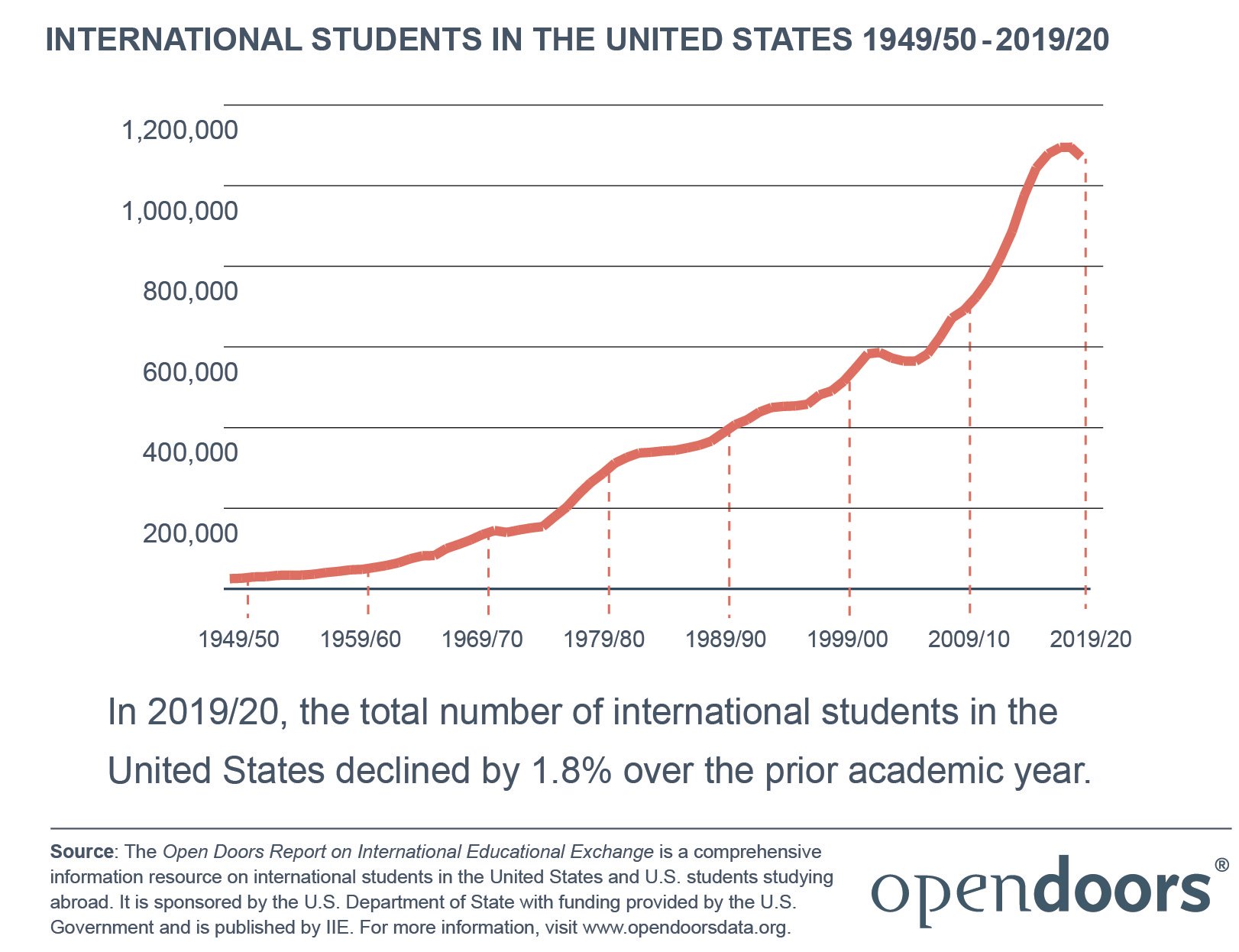You have /5 articles left.
Sign up for a free account or log in.

Chris Delmas/Getty Images
The total number of international students studying at U.S. universities, whether from within the U.S. or online from abroad, decreased by 16 percent this fall, while enrollments of new international students decreased by 43 percent, according to a new survey of more than 700 colleges conducted by 10 major higher education organizations.
The survey provides a first look at how hard international enrollments have been hit by the COVID-19 pandemic. The survey found that one in five international students are studying online from outside the U.S. Ninety percent of responding institutions reported student deferrals, collectively reporting that nearly 40,000 international students have deferred their studies to a future term.
“We’ve never had a decrease like that,” said Allan E. Goodman, president of the Institute of International Education, one of the organizations that conducted the survey. “What we do know is when pandemics end, there’s tremendous pent-up demand. All of our records show in the past that when it’s safe to resume travel, we’re dealing with surges of students that have deferred, that set their plans aside, that were granted deferments and want to come. I think there’s no reason to suspect that at the end of this pandemic we won’t see the same thing.”
Apart from the survey data on this fall’s enrollment, IIE released data today on international enrollments for the 2019-20 academic year today from its annual Open Doors survey, a survey of more than 2,900 colleges done in partnership with the U.S. Department of State. The pre-pandemic data show a 0.6 percent decline in new international enrollments in 2019-20 -- the fourth straight year of declines in new international enrollments -- and a 1.8 percent decrease in the total number of international students. The decline in total international student numbers is the first recorded year-over-year decline in total international student numbers since 2005-06.
New and Total International Student Enrollments at U.S. Universities
| New International Enrollments | Percent Change From Prior Year | Total International Enrollments | Percent Change From Prior Year | |
| 2015-16 | 300,743 | +2.4% | 1,043,839 | +7.1% |
| 2016-17 | 290,836 | -3.3% | 1,078,822 | +3.4% |
| 2017-18 | 271,738 | -6.6% | 1,094,792 | +1.5% |
| 2018-19 | 269,383 | -0.9% | 1,095,299 | +0.05% |
| 2019-20 | 267,712 | -0.6% | 1,075,946 | -1.8% |
An analysis by NAFSA: Association of International Educators of the economic impact of international students similarly recorded a decline in its estimate of international students’ contributions to the U.S. economy. NAFSA estimates that international students contributed $38.7 billion to the U.S. economy in 2019-20, a 4.4 percent decline from the year before.
“Unfortunately, this disappointing news is not surprising,” Esther D. Brimmer, NAFSA’s executive director and CEO, said in a statement. “For the past four years international students and scholars have had to endure travel bans, executive orders, detrimental regulatory actions and xenophobic rhetoric from the highest levels of U.S. government. The lack of a coordinated national pandemic response made the situation even more difficult.”
Many international educators expect the current approach to international enrollment to change after President-elect Joseph Biden assumes office, and they are anticipating a reset away from Trump administration policies and rhetoric they argue have been detrimental to America’s ability to attract international students.
Anthony Koliha, the director of the Office of Global Educational Programs at the State Department, expressed the Trump administration’s commitment to attracting international students, during a press briefing on the Open Doors data Thursday: “As President Trump has stated, ‘our universities are available. The world comes in. They use our universities. We have the greatest system in the world,’” Koliha said. "Over the past year, the Trump administration has invested more in educational advising for the State Department’s Education USA network than any administration in history. These investments will help maintain and grow the United States as a top host nation for international students."
International Enrollments
The Open Doors data show a 2.9 percent decline in international undergraduate enrollment in 2019-20 compared to the year before, and a 0.9 percent decline in international graduate enrollment. The number of international students in nondegree programs, including intensive English programs, decreased by 6.6 percent.
The number participating in optional practical training, a program that allows students to stay in the U.S. to work in a job related to their field of study for up to three years after graduating, stayed essentially flat, increasing by just 0.2 percent after years of sizable increases. Indeed, large increases of students on OPT have buoyed overall international student numbers in recent years, keeping the overall trend line positive even as there were decreases in new students.
International Enrollment by Academic Level
| Undergraduate | Percent Change From Prior Year | Graduate | Percent Change From Prior Year | Nondegree | Percent Change From Prior Year | Optional Practical Training | Percent Change From Prior Year | |
| 2015-16 | 427,313 | +7.1% | 383,935 | +6% | 85,093 | -9.1% | 147,498 | +22.6% |
| 2016-17 | 439,019 | +2.7% | 391,124 | +1.9% | 79,984 | -14.2% | 175,695 | +19.1% |
| 2017-18 | 442,746 | +0.8% | 382,953 | -2.1% | 65,631 | -10.1% | 203,462 | +15.8% |
| 2018-19 | 431,930 | -2.4% | 377,943 | -1.3% | 62,341 | -5% | 223,085 | +9.6% |
| 2019-20 | 419,321 | -2.9% | 374,435 | -0.9% | 58,201 | -6.6% | 223,539 | +0.2% |
More than half (52.6 percent) of international students in the U.S. in the 2019-20 academic year came from either China or India. The number of students from the leading country of origin, China, increased by 0.8 percent, while the number from the second leading country, India, fell by 4.4 percent.
There were also declines in students from the next four biggest countries of origin: South Korea (-4.7 percent), Saudi Arabia (-16.5 percent), Canada (-0.5 percent) and Vietnam (-2.5 percent).
The academic year 2019-20 marked the fourth straight year of double-digit percentage declines in the number of students from Saudi Arabia, a decline that started when the government scaled back a large-scale foreign scholarship program.
Rounding out the top 10 countries of origin for international students are Taiwan (+1.5 percent), Japan (-3 percent), Brazil (+3.8 percent) and Mexico (-5.8 percent).
 Outside the top 10, the number of students from the 13th-largest country of origin, Iran, decreased by 5.7 percent, following a 5 percent decrease the year before. There were multiple cases during the last academic year of Iranian students being denied entry to the U.S. despite possessing valid visas. The country is among those subject to the Trump administration's travel ban on a group of mostly Muslim-majority countries, though there is an exception to the ban to allow Iranian students and exchange scholars to travel.
Outside the top 10, the number of students from the 13th-largest country of origin, Iran, decreased by 5.7 percent, following a 5 percent decrease the year before. There were multiple cases during the last academic year of Iranian students being denied entry to the U.S. despite possessing valid visas. The country is among those subject to the Trump administration's travel ban on a group of mostly Muslim-majority countries, though there is an exception to the ban to allow Iranian students and exchange scholars to travel.
Students studying STEM fields, including health professions fields, made up 51.6 percent of all international students in 2019-20. The numbers of students studying engineering, the most popular field for international students, declined by 4.4 percent. The number studying math and computer science, the second most popular field, increased by 0.9 percent. The number studying business and management, the third most popular field, declined by 4.2 percent.
For the fifth straight year, the number of international students in the U.S. topped one million, 1,075,496, which is almost double the number the U.S. hosted in the year 2000 (547,867). IIE estimates that international students account for 5.5 percent of all students in the U.S., a proportion that has stayed steady for three years.
“There is substantial capacity for campuses to host more international students,” said Mirka Martel, IIE’s head of research, evaluation and learning.








